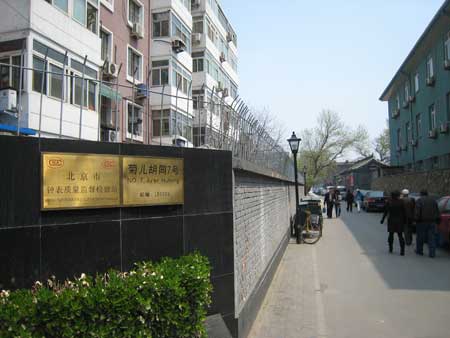Great leap back in time: Ju'er Hutong
|
|
|
Ju'er Hutong. Photo: Yin Yeping |
Capped by Jiaodaokou South Main Street to the east and Nanluoguxiang to the west, the 400-meter Ju'er Hutong, like many other lanes around this area, dates back to the Yuan dynasty. Because this hutong is narrow and long, like a centipede, Ju'er is also called Centipede Lane.
During the Qing Dynasty, this was the gathering place of the Xiang Huang bannermen, an upper class brigade of the eight banners commanded by the emperor. For an additional elite historical claim, addresses No. 3, 5 and 7 held the former residence of Rong Lu, the provincial governor and minister of war during the late Qing Dynasty.
Home of a right-hand man
With his absolute loyalty and commitment to the Qing government, Rong Lu was the right-hand man of the empress Ci Xi, especially when she interfered to stop the emperor's Hundred Days Reform; her meddling led to the emperor Guang Xu being put in chains. Rong Lu's obstinate slogan, "the ancestors' traditions shall not be changed," ensured that he made no contribution to the country's general progress.
Important government officials needed houses to match their titles; No. 3, 5 and 7 once all belonged to Rong Lu's family, passed down from his father. The three doors each served as an ancestors' memorial temple, the residence and a garden. Now, on these grounds, one can only find the Beijing First Light Manufacturing Research Institute and some residential buildings.
Fortunately, No. 3 remains. In 1986 it received designation as a cultural relic unit of Dongcheng district (as noted on the door), but it's only referenced as an "old siheyuan." Within, one finds a mess of new construction, but it's still possible to tell that the four houses surrounding a courtyard were once part of a bigger feature.
Zhou (who inexplicably refused to offer her full name for this story), 60, has lived here since 2003, but most of the 11 families living here are strangers even to her. "The children of the dead owners just sold the house to outsiders for more than two million yuan." She pointed at the old house up front, where additions were in progress: "Most of the houses like this were built by these new owners." Zhou said that the siheyuan was beautifully original when she moved in. "This was the second inner courtyard, and the one on its east was the first," she explained. "They were all accessible to each other."
In that case, Rong Lu's place might have had its main gate facing today's Jiaodaokou instead of Ju'er Hutong, as it is now. The front yard is not difficult to find; peek through its locked red door to see the emptied houses and broken bricks abandoned inside, seemingly waiting for the next rich owners to move in.
 0
0 









Go to Forum >>0 Comments